
• Originally used for finishing EDM surfaces.
• Best suited to poorly conducting materials, and brittle materials.
• The basic process is a ductile and tough tool is pushed against the work with a constant force. A constant stream of abrasive slurry passes between the tool and the work to provide abrasives and carry away fractured particles. The majority of the cutting action comes from an ultrasonic (cyclic) force applied in addition to the other force.

• The basic components to the cutting action are believed to be,
1. The direct hammering of the abrasive into the work by the tool (major factor)
2. The impact of the abrasive on the work
4. Chemical erosion caused by slurry
• M.C. Shaw generated a model to estimate the cutting action.

• Consider the impact pictured below.

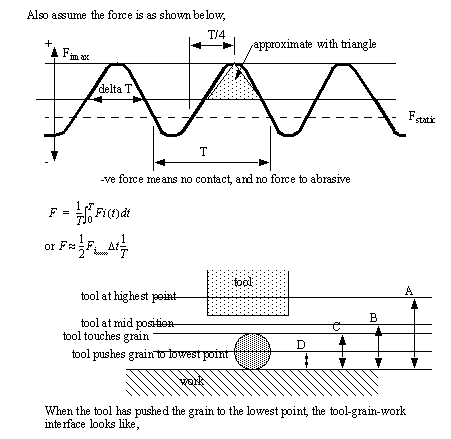
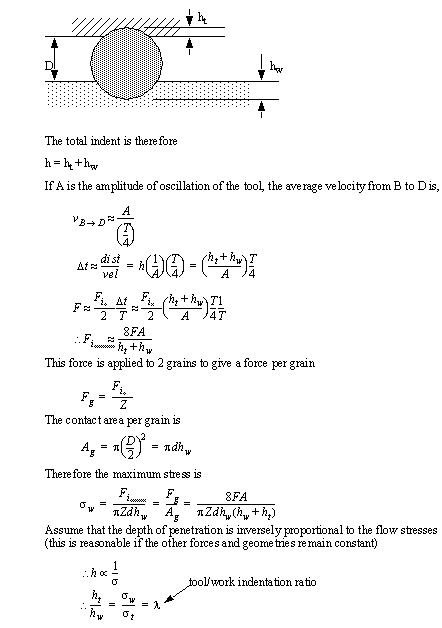

• Material is also removed by grains moving quickly and building up kinetic energy. When they strike the work surface, they transfer their energy quickly causing surface work. This effect is smaller than hammering.
• The grains are not actually perfectly spherical, and as a result smaller rounds actually lead to faster machining.
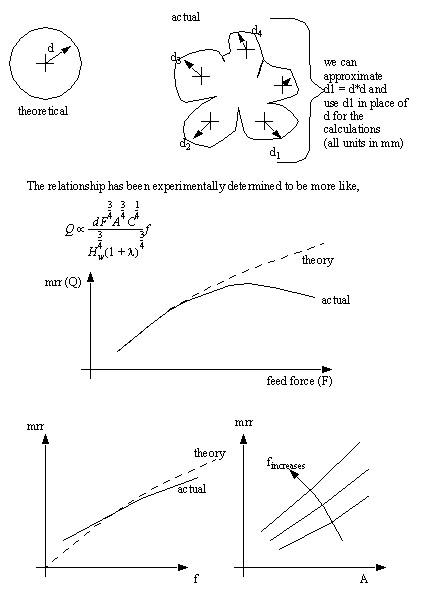
• mmr decreases when static force F gets high enough to crush abrasive grains.
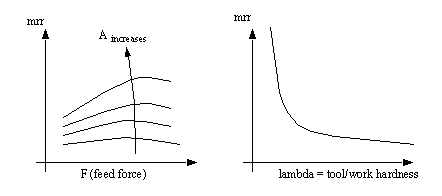
• f = 16.3 KHz, A = 12.5 micro m, grain = 100 mesh.

• If d approaches A the grains start to crush.
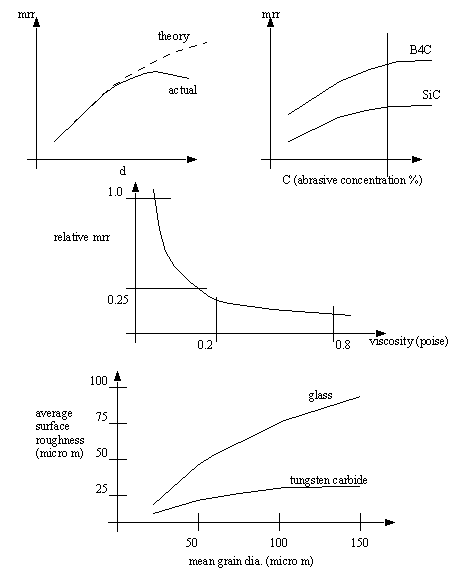
• Example: Find the machining time for a hole 5mm in diameter in a tungsten carbide plate 1cm thick. The grains are .01mm in diameter, the feed force is 3N, and the amplitude of oscillation is 20 micro m at a frequency of 25KHz. The fracture hardness is approximately 6900N/mm2. The slurry is mixed in equal parts water and abrasive.


• The acoustic head is the most complicated part of the machine. It must provide a static force, as well as the high frequency vibration
• The magnetostrictive head is quite popular,

• Magnetostrictive materials should have a good coupling of magnetic and mechanical energy,

• The vibrating head is supplied with a constant force using,

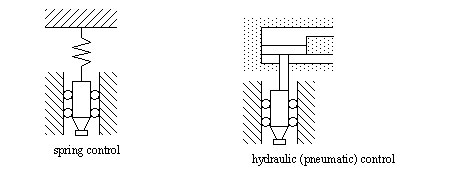
• If a tool is designed to increase flow, better cutting speeds will occur.
stainless steel and low carbon
aluminum and brass tools wear near 5 to 10 times faster
boron carbide (B4C) good in general, but expensive
silicon carbide (SiC) glass, germanium, ceramics
diamond (used for rubies, etc)
boron silicarbide (10% more abrasive than B4C)
typical grit size is 100 to 800
• Little production of heat and stress, but may chip at exit side of hole. Sometimes glass is used on the back side for brittle materials.
• Summary of USM characteristics
mechanics of material removal: brittle fracture caused by impact of abrasive grains due to vibrating at high frequency
abrasives: B4C; SiC; Al2O3; diamond; 100-800 grit size
vibration freq. 15-30 KHz, amplitude 25-100 micro m
material/tool wear = 1.5 for WC workpiece, 100 for glass
critical parameters: frequency, amplitude, tool material, grit size, abrasive material, feed force, slurry concentration, slurry viscosity
material application: metals and alloys (particularly hard and brittle), semiconductors, nonmetals, e.g., glass and ceramics
shape application: round and irregular holes, impressions
limitations: very low mrr, tool wear, depth of holes, and cavities small.
• USM twist drilling has been done by attaching a magnetostrictive head to the spindle shelf.
28.2 Ghosh, A., Manufacturing Science, Ellis Horwood Ltd., Chichester, UK, 1986.
Problem 28.2 A cylindrical impression with a diameter of 10mm and a depth of 1mm has to be made on a tungsten carbide surface. The feed force is constant and equal to 5N. The average diameter of the grains in the abrasive slurry is 0.01mm. The tool oscillates with an amplitude of 30 micro m at 20 KHz. The slurry contains 1 part of abrasive to about 1 part of water. The fracture hardness of tungsten carbide workpiece may be taken as 7000 N/mm2. Estimate the machining time.
Problem 28.3 A square through hole of 5mm by 5mm has to be drilled in a 5mm thick tungsten carbide sheet. The slurry is made of 1 part of 10 micro m radius boron carbide grains mixed with 1.5 parts of water. The feed force is 4N. The tool oscillates with an amplitude of 0.015mm at 25KHz. Assuming that only 20% of the pulses are effective, calculate the time required to complete the job.
Problem 28.4 In an ECM operation, a pure copper block is being machined. If a current of 5000A is used, determine the volume rate of material removal from the copper block.
Problem 28.5 The composition of a Nimonic alloy turbine blade is 18% cobalt, 62% Ni, and 20% chromium. It is being machined electrochemically with a current of 1500A. Find out the volume removal rate if the density of the alloy is 8.3g/cm3. The dissolution valency of chromium is 6, whereas that for both nickel and cobalt is 2.
Problem 28.6 The composition of a monel alloy workpiece undergoing electrochemical machining is as given here:
63% Ni, 31.7% Cu, 2.5% Fe, 2% Mn, 0.5% Si, 0.3% C
if the machining current is 1000A, estimate the volume removal rate.
Problem 28.7 The equilibrium gap when machining (electrochemically) iron, using NaCl solution in water as the electrolyte, is found to be 0.2mm. The current density is 200A/cm2, the operating voltage being 12V. Iron dissolves at a valency 2, the density of iron is 7.8 g/cm3, and the specific resistance of the electrolyte is 2.8 ohm cm. Calculate the metal removal rate/unit work surface area. The overvoltage may be taken as 1.5V
Problem 28.8 In an electrochemical trepanning operation on a flat iron surface, an electrode in the form of a tube (with an outer diameter of 1cm). A laser beam with a power intensity of 2 * 105 W/mm2 is used to drill a 0.2mm diameter hole in a tungsten sheet of 0.4mm thickness. If the efficiency of the operation is only 10%, estimate the time required.
Problem 28.9 TRUE / FALSE: Water is the main cutting tool in Ultra Sonic machining.
Problem 28.10 Why are the vibrations in USM so small?
Problem 28.11 USM will be used to add the following pattern to an object, If the tool is Tungsten carbide, and the work is Cu, with an amplitude of oscillation of 10 μm, at 30KHz, how long will the operation take? (Note: the grain diameter is 20μm, and the head has a static force of 6N)

Problem 28.12 When is the abrasive added into the flow for the various abrasive jet machining processes?
Problem 28.13 Why is the depth of material removed by abrasive jet machining so variable?
Problem 28.14 Describe the ability of the abrasive processes to produce sharp corners.